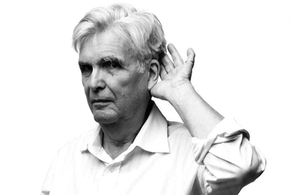 Quebec composer Gilles Tremblay.
Quebec composer Gilles Tremblay. The vocal ensemble at the centre of this veneration of the Virgin Mary was Soundstreams’ own Choir 21, directed by David Fallis. As well, there were two instrumental groups on stage (at different times): a baroque “period” band for the Monteverdi; and a modern ensemble for the Tremblay, which also included a soprano soloist, Shannon Mercer.
I was grateful for this decision: in its entirety, Monteverdi’s Vespers is an hour-and-a-half proposition. Also, in my opinion – and I know that many would disagree with me – the Vespers suffers from “Zarathustra syndrome”: a glorious beginning followed by some rather tedious and underwhelming movements. I saw nothing wrong with leaving some of them out.
And on this occasion, the opening “Deus in adjutorium” movement was indeed glorious. Strings, cornettos, sackbuts and a small organ all contributed to a lively fanfare while the choir sang its sonorous, tonally transfixed chant like the End of Time had burst upon us. It was a hard act to follow – and what followed was of uneven quality.
Intonation became a problem in the “Ave maria stella” movement. And something went wrong with the opening pitches in the “Magnificat” – so wrong that Fallis had to stop the choir and start over. Also, the use of small vocal groups, each singing a stanza of the “Magnificat” text, served to remind that not all choristers make good soloists. That said, I have only high praise for the tenor who sang some crazy-brilliant ornaments on the word “Gloria.”
Tremblay’s Vêpres (premiered 28 years ago in France, at the Abbey of Notre-dame de Sylvanès) called for a very different kind of instrumental ensemble: modern winds, organ, bass and percussion – lots of percussion.
The piece begins with an extended flute solo, “Envol.” The movement makes much use of extended techeniques – overblowing, underblowing, mirctotones, etc. – and it was played with steely intensity by Leslie Newman, from the balcony.
The “Gloria” that followed seemed to be clearly influenced by the opening of the Monteverdi Vespers. A clangorous outburst from the band accompanied a monolithic, chordal setting of “gloire au Père et au Fils, et au Saint-Esprit.” (Most of the text of the Tremblay is in French.). It was unapologetically gnarly stuff – and for anyone in the audience who might not have already known of Tremblay, this music established the Quebec-based composer’s high-modernist bona fides: dissonant, angular, austere, and as “new-musicky” as heck.
In successive movements, Tremblay found his historical inspiration in Gregorian chant. There was plenty of unison choral writing, which became relentless in the “Ave maria stella” movement, and elsewhere. Fortunately, Tremblay is a composer with keen instincts where instrumental colour is concerned, and his sparing but effective use of unusual instrumental combinations – organ with crotales, for example – was impressive.
Also impressive was Mercer. Her extended solo passage in the “Magnificat” – a vocalise that starts off with fairly normal singing, but soon incorporates every manner of shriek and wail – was a tour de force.
If you’d like to check out Tremblay’s Vêpres for yourself, a good recording may be found online, here.
© Colin Eatock 2014
 RSS Feed
RSS Feed

